

Practical Bioinformatics Mark Voorhies 4/20/2011 Mark Voorhies Practical Bioinformatics
Review Corrected slides for days 1 and 2 are on the website Mark Voorhies Practical Bioinformatics
Review Corrected slides for days 1 and 2 are on the website Each byte in a text file can be translated as a human-readable character. Mark Voorhies Practical Bioinformatics
Review Corrected slides for days 1 and 2 are on the website Each byte in a text file can be translated as a human-readable character. The different operating systems differ only in how they mark the end of a line: UNIX: \ n (linefeed) MacOS: \ r (carriage return) Windows: \ r \ n (CRLF) Mark Voorhies Practical Bioinformatics
Review Corrected slides for days 1 and 2 are on the website Each byte in a text file can be translated as a human-readable character. The different operating systems differ only in how they mark the end of a line: UNIX: \ n (linefeed) MacOS: \ r (carriage return) Windows: \ r \ n (CRLF) Here’s how to fix the \ r problem on OS X: tr ’ \ r’ ’ \ n’ < macfile.txt > unixfile.txt Mark Voorhies Practical Bioinformatics
Review Corrected slides for days 1 and 2 are on the website Each byte in a text file can be translated as a human-readable character. The different operating systems differ only in how they mark the end of a line: UNIX: \ n (linefeed) MacOS: \ r (carriage return) Windows: \ r \ n (CRLF) Here’s how to fix the \ r problem on OS X: tr ’ \ r’ ’ \ n’ < macfile.txt > unixfile.txt Loading and re-loading your modules # Use import the f i r s t time you load a module # (And keep us i ng import u n t i l i t l o a d s # s u c c e s s f u l l y ) import my module my module . my function (42) # Once a module has been loaded , use r e l o a d to # f o r c e python to read your new code r e l o a d ( my module ) Mark Voorhies Practical Bioinformatics
Gotchas If the same value will be referred to many times, save it in a variable def stdev ( x ) : m = mean( x ) s = 0.0 f o r i i n x : s += ( i − m) ∗∗ 2 from math import s q r t return s q r t ( s /( l e n ( x ) − 1)) Mark Voorhies Practical Bioinformatics
Gotchas If the same value will be referred to many times, save it in a variable def stdev ( x ) : m = mean( x ) s = 0.0 f o r i i n x : s += ( i − m) ∗∗ 2 from math import s q r t return s q r t ( s /( l e n ( x ) − 1)) Use list comprehensions for vector operations v = [ 3 , 2 , 4 , 5 , 1 ] a = v ∗∗ 2 # no a = [ i ∗∗ 2 i v ] # yes f o r i n Mark Voorhies Practical Bioinformatics
Gotchas If the same value will be referred to many times, save it in a variable def stdev ( x ) : m = mean( x ) s = 0.0 f o r i i n x : s += ( i − m) ∗∗ 2 from math import s q r t return s q r t ( s /( l e n ( x ) − 1)) Use list comprehensions for vector operations v = [ 3 , 2 , 4 , 5 , 1 ] a = v ∗∗ 2 # no a = [ i ∗∗ 2 i v ] # yes f o r i n v �� | v | i =1 v 2 i norm = s q r t (sum( i ∗∗ 2 f o r i i n v ) ) u n i t = [ i /norm f o r i i n v ] Mark Voorhies Practical Bioinformatics
Object oriented programming Mark Voorhies Practical Bioinformatics
Recommend
More recommend